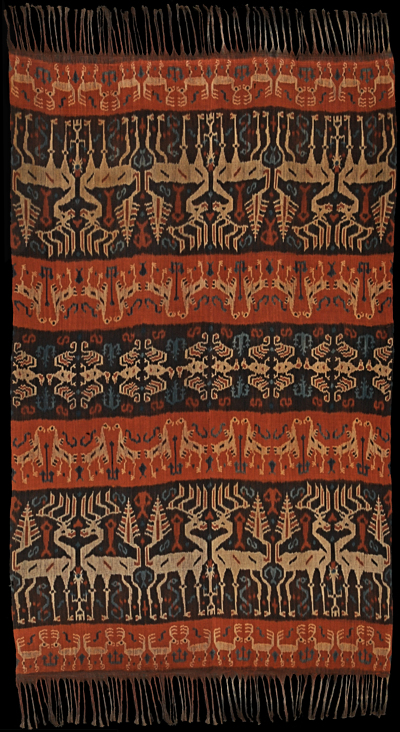| |
 
 | | | |
299 Sumba, East Sumba
Hinggi (men's blanket)  
| | Locale: | Kanatang | | Period: | 19th to very early 20th | | Yarn: | Cotton, hand-spun, very fine, double-ply, single weft (the mark of an apex Sumba weaving) | | Technique: | Warp ikat | | Panels: | 2 | | Size: | 170 x 250 cm (5' 6" x 8' 2") LW: 1.47 | | Weight: | 945 g (33.3 oz), 222 g/m2 (0.73 oz/ft2) | | Design: | The widest ikated bands are decorated with six large stags in oppositional pairs. Note that there are three per panel, not an even number, meaning that the panels could not use a longitudinal repeat. The spaces between the animals have been filled with other zoomorphic elements: snakes between the legs, sand-strikers (sea-worms) between a stag's rack and its tail, stylized into a tree of life shape. The outermost ikated bands show cockatoos, a Katang hallmark. The middle band carries what appears to be a creative expression of the habak (habaku) motif, the prerogative of the Kanatang royal family, using opposed fruitbats with outstretched wings. | | Comment: | HInggi in hondu wallah construction with an asymmetric centreband. (For the cloth to be symmetric the fruits bats would have had two have two snouts, one facing up, the other down - a hidden key.) The yarn is very fine and wildly irregular, typical for early cloth. It is some some of the finest hand-spun encountered on Sumba, weighing just 222 g/m2., Its low weight conveys a sense of luxury. The almost chiseled drawing - was achieved by the use (extremely rare) of single weft rather than the common twin weft. The styling of the deer, with their elongated, thin shapes, has a remarkable elegance. The creative way space was created between the stags' behinds to fit in an aquatic motif is not unique, but seen on only a few of the many hinggi with stag motifs inspected. Deeply saturated morinda with the tonality of burnt sienna contrasts with the natural ecru of the main reserved areas and light blue accents. The ageing cotton has the soft patina of a cherished cloth that has been sparingly used for a long time. Four very small repairs. From old Dutch collection. | | Background: | Chapters on Sumba and East Sumba. | | Published: | Ikat from Timor and its Outer Islands, 2022.
Noble Virtuosity: Hidden Asymmetry in Ikat from Sumba, 2024. | | Compare: | 188 187 027 222 319 | | Sources: | Similar to hinggi in Deutsches Textilmuseum, Krefeld, Inv. Nr. 16627, depicted in Khan Majlis's supplement to Völger and von Welck, Indonesian Textiles, Fig. 162. It also has deer as the main motif and bats in the midsection, albeit drawn less elegantly. Similar motifs on early 20th c. hinggi in the Nusantara Collection now at Wereldculturen, Leyden, 7082-S-878-1 and to 7082-S-2086-10. Both of these though have, certainly in the case of the former, less refined styling. Motifs also similar to a hinggi from the same period in the Textile Research Centre, equally in Leyden, TRC 2000.0085, but again with less refined drawing of the stags. Similar to hinggi in Khan Majlis's supplement to Völger and von Welck, Indonesian Textiles, Fig. 162, which also has deer as the main motif and bats in the asymmetric midsection, albeit drawn less elegantly. Similar motifs on early 20th c. hinggi in the Nusantara Collection now at Wereldculturen, Leyden, 7082-S-878-1 and to 7082-S-2086-10. Both of these though are simpler, with less refined styling. Motifs also similar to a hinggi from the same period in the Textile Research Centre in Leiden, TRC 2000.0085, but this also has with less refined drawing of the stags. | | |

©Peter ten Hoopen, 2025
All rights reserved.
|
|


